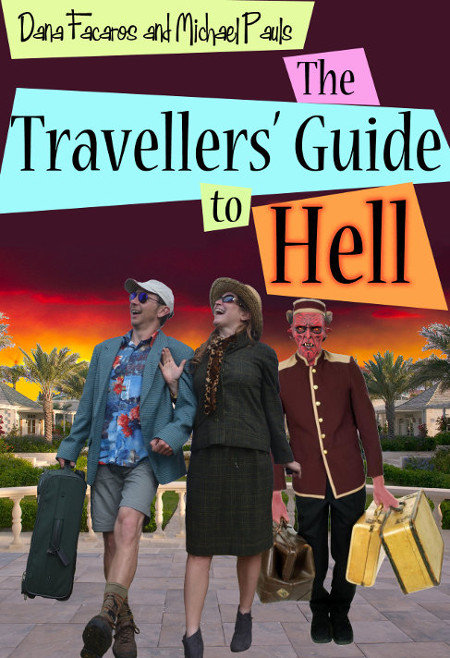Join the rich and famous in the world’s hottest resort!
Everything you need to know: an exhaustively researched history of hell, how to get there, what to bring, what to eat (don’t), who’s who among the demons and devils, an update of Dante’s Inferno (from guest visionary, Rev. Odus Lee Wiggins) and a round-up of all the world’s hells—from ancient Mesopotamia to the Kafka-esque bureaucratic Chinese hell, Buddhist hell with its mean chickens to William Blake’s infernal poetic backwards Bible.
Michael was interviewed on the Seven Deadly Sins by Ernie Rea on BBC Radio 4’s Beyond Belief. Listen to part of the interview:
The Seven Deadly Sins – an excerpt from The Travellers’ Guide to Hell

The most entertaining route to Hell is still the old-fashioned way: being bad. The Seven Deadly Sins were set up as guidelines to just the kind of misbehaviour required, and by carefully committing the right ones, you may well land that certain place in Hell you really want.
The origins of the Seven are somewhat surprising. In Roman times, Christianity faced some tough competition from other mystery religions. Many of these proffered decent afterlife benefits, but none of them had Christianity's great disadvantage in this world: a chance of being converted into lion fodder. Because of this handicap, the early Christians reverted to some slightly underhand methods in the battle for converts, including the pirating of symbols, ideas and holidays from their rivals. The Seven Deadly Sins were copied wholesale from the arch-rival sect of Mithraism, only substituting Gluttony for Ambition, which Mithraism held as the king of all vices. There are seven, of course, because everything in the ancient world goes in sevens, one for each of the visible planets.
Dedicated to keeping the canon up to date, the long-established and instructive Deadly Sins' homepage (www.deadlysins.com), reveals that in modern times the Sins have gone undercover to infiltrate children's minds-for example as the dwarfs in Walt Disney's Snow White:
‘Seven shrunken men shacked up in a secluded forest cabin, hiding a virginal teenage runaway. Seven tortured forms shouldering their demonic tools as they march into the hellish bowels of the earth, singing as they go...’
Adam Shannon, the monk in charge of deadlysins.com, also offers the best explanation for an insidious vehicle that launched the Deadly Seven straight into the heart of Middle America's living rooms—the 1965-67 sitcom Gilligan's Island. Gilligan and six other castaways, trapped on a Pacific island, seem to be as harmless and oafish as any characters on American TV, and yet the show turns out to be:
‘a Sartre-like nether-world in which the characters represent the Seven Deadly Sins, forced in the days after Armageddon (in the form of the Flood) to live in unceasing torment with each other.’
Sherwood Schwarz, the show’s producer, only admitted years later that a parable on the Sins was exactly what he had in mind. For those who remember the show (94.3% of American baby-boomers), the Skipper represented Wrath, and as for the rest: the Professor (Pride), Ginger (Lust), Mary Ann (Envy), Thurston Howell III (Greed) Mrs. Howell (Gluttony), and Gilligan himself (Sloth). An alternative interpretation has the friendly but clueless Gilligan, who always wears red and fouls up every rescue attempt, as the Devil himself.
Not only hidden in Disney and on Gilligan's Island, the Sins have been openly present in such diverse entertainments as Kurt Weill's musical on the Deadlies (Die Sieben Todsünden, 1933) and the gruesome Brad Pitt/Morgan Freeman serial killer flick, Seven. They have been perceived in Charlie and the Chocolate Factory and America’s Next Top Model. Now, we see them everywhere in kid culture—comics and cartoons (especially Japanese manga and anime) and even video games . It's a shame there were only four Spice Girls. The truth is, thanks to modern technology, the Deadlies have become bigger and brasher than ever, and pop culture openly encourages every last one of them.
In February 2010, a BBC publication called Focus, which calls itself a ‘magazine of science, technology and the future’, came up with the first international ratings for the big seven. The methodology is somewhat unclear, but South Koreans topped the list in Lust, Mexicans in Greed and Americans in Gluttony (who knew?). Wrath went to South Africa, and Envy, in a surprise upset, was awarded not to the UK but Australia. Icelanders, of all people, came out champs in both Sloth and Pride (that was when they still had money in the bank). But the overall winner as the most sinful nation in the world was—the envelope please—Australia! And we thought they were only tedious, sports-mad tossers.
© Dana Facaros & Michael Pauls

